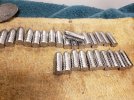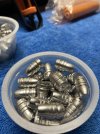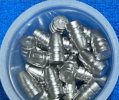I just tuned up two used but new to me Lyman moulds tonight and cast with them. Both had warped sprue plates from people beating on them. About .005-8" gap opposite the sprue plate screw. I took off the sprue plates, checked the "daylight" under them on a granite surface plate, checked the top of the blocks with a straightedge, tweaked the corners back down, did a light dress with 400-grit emery paper on a scraped surface plate, test fitted, dressed a little more, and put them together. The plates swing without binding but don't move under their own mass when I shake the mould. I use an Ove Glove and cut the sprue before it sets up hard as a rock. You don't NEED a thicker sprue plate, you need to tune up your methods and quit beating on the mould with a club.
Casting is all about managing heat and how you fill the mould. Lots of ways to do it but some basic guidelines such as have already been recommended should be followed if you want to get in the ballpark where practicing technique will make you better. No point in practicing if your alloy is contaminated or you're overheating your alloy so badly it runs into the vent lines and plugs them up.
I poured these tonight just like Brad showed except I'm poor and only have a 20-lb RCBS dipper furnace instead of a Waage or Magma (I forget what he has but it's awesome and if you can treat yourself to something like that, you should). I do not pressure pour, ever. I DO use a 2# Rowell ladle instead of the rinky-dink 1# ones that people like to use to pressure pour. Pouring like Brad showed cuts way down on the trapped bubbles, contacting and rotating the mould and ladle together usually traps bubbles in the driving band area just under the surface....ask me how I learned that 30 years ago. I rarely ladle pour but sometimes big bullets and match bullets need it.




